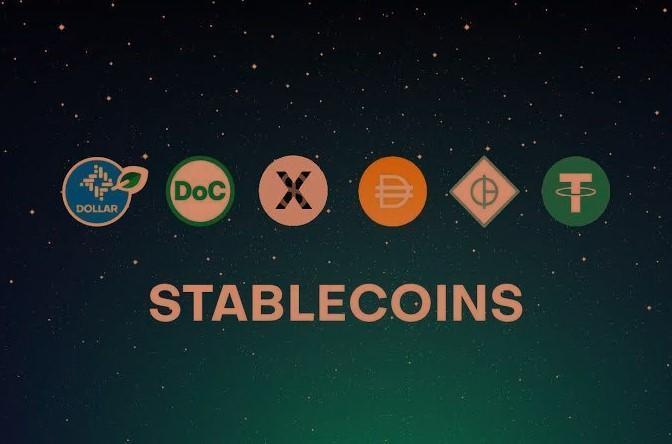Stablecoins are cryptocurrencies that are designed to maintain a stable value relative to a traditional currency, such as the US dollar or the Euro. Stablecoins are becoming increasingly popular in the cryptocurrency space, as they offer a way to overcome the volatility that is typically associated with cryptocurrencies. In this article, we will explore the basics of stablecoins, including their definition, purpose, and technological infrastructure.

Contents
What are Stablecoins?
Stablecoins are cryptocurrencies that are designed to maintain a stable value relative to a traditional currency or an asset, such as gold or oil. Stablecoins are typically pegged to the value of the asset they are tracking, and their value is maintained through a variety of mechanisms, such as over-collateralization, algorithmic adjustments, or regular audits.
– How to Choose an Altcoin: Factors to Consider
Purpose of Stablecoins
Stablecoins serve several purposes in the cryptocurrency space. First, they provide a stable store of value for users who are looking to hold cryptocurrencies but want to avoid the volatility that is typically associated with cryptocurrencies. Second, stablecoins provide a way to transact in cryptocurrencies without being exposed to the price fluctuations of traditional cryptocurrencies. Finally, stablecoins provide a bridge between the traditional financial system and the cryptocurrency space, allowing users to move funds between the two systems without having to convert their holdings into a traditional currency.
Types of Stablecoins
There are several types of stablecoins, including fiat-backed stablecoins, commodity-backed stablecoins, and algorithmic stablecoins. Fiat-backed stablecoins are backed by traditional currencies, such as the US dollar or the Euro, and are typically issued by a central authority. Commodity-backed stablecoins are backed by commodities, such as gold or oil, and are typically issued by a commodity exchange. Algorithmic stablecoins are backed by a set of rules and algorithms that maintain their value.
Technological Infrastructure
Stablecoins are typically built on top of a blockchain, such as Ethereum or Bitcoin, and use smart contracts to maintain their value. The smart contracts are programmed to automatically adjust the supply of the stablecoin based on changes in demand, ensuring that the stablecoin maintains its peg to the asset it is tracking. Some stablecoins also use off-chain mechanisms, such as regular audits or reserve management, to maintain their value.
Importance of Stablecoins
Stablecoins are becoming increasingly important in the cryptocurrency space, as they offer a way to overcome the volatility that is typically associated with cryptocurrencies. Stablecoins provide a stable store of value, a way to transact in cryptocurrencies without being exposed to price fluctuations, and a bridge between the traditional financial system and the cryptocurrency space. Additionally, stablecoins have the potential to be used in a variety of applications, such as remittances, micropayments, and decentralized finance (DeFi) applications.

The Rise of Stablecoins: An Overview of the Top Players in the Market
Stablecoins have become an increasingly popular type of cryptocurrency in recent years. As their name suggests, stablecoins are designed to maintain a stable value, unlike other cryptocurrencies such as Bitcoin and Ethereum which are known for their volatility. Stablecoins offer several benefits, including a more predictable and stable value, faster transaction times, and lower fees. In this article, we will take a closer look at the most well-known stablecoins.
Tether (USDT)
Tether is currently the largest and most widely used stablecoin, with a market cap of over $70 billion as of 2023. It is designed to maintain a 1:1 peg with the US dollar, meaning that one USDT is always equal to one US dollar. Tether is used by many cryptocurrency traders and exchanges as a means of moving funds quickly and cheaply.
– FOMO: Understanding the Fear of Missing Out in Cryptocurrency Investing
USD Coin (USDC)
USD Coin is another popular stablecoin that is pegged to the US dollar. It was launched in 2018 by Circle, a financial technology company, and Coinbase, a cryptocurrency exchange. USDC has a market cap of over $43 billion as of 2023 and is widely used by traders and investors looking for a stable and reliable cryptocurrency.
Dai (DAI)
Dai is an algorithmic stablecoin that is designed to maintain a stable value relative to the US dollar. Unlike Tether and USDC, Dai is not backed by any traditional currency or commodity. Instead, it is backed by a basket of other cryptocurrencies, including Ethereum. Dai has gained popularity among users who are skeptical of the centralized nature of Tether and other stablecoins.
Binance USD (BUSD)
Binance USD is a stablecoin launched by Binance, one of the world’s largest cryptocurrency exchanges. It is designed to maintain a 1:1 peg with the US dollar and has a market cap of over $3 billion as of 2021. Binance USD is primarily used by traders and investors on the Binance exchange, but it is also supported by several other exchanges and wallets.
TrueUSD (TUSD)
TrueUSD is a stablecoin launched in 2018 that is designed to maintain a 1:1 peg with the US dollar. It is backed by US dollars held in escrow accounts and is audited regularly to ensure transparency and compliance with regulations. TrueUSD has a market cap of over $400 million as of 2021 and is used by traders and investors looking for a stable and secure cryptocurrency.
In conclusion, stablecoins have become an important part of the cryptocurrency ecosystem, offering users a more stable and predictable alternative to other cryptocurrencies. While there are many stablecoins available, the above-mentioned five stablecoins are currently the most widely used and recognized in the market.
– How to Invest in Cryptocurrency Exchanges at the Right Time
Conclusion
Stablecoins are cryptocurrencies that are designed to maintain a stable value relative to a traditional currency or an asset. Stablecoins serve several purposes in the cryptocurrency space, including providing a stable store of value, a way to transact in cryptocurrencies without being exposed to price fluctuations, and a bridge between the traditional financial system and the cryptocurrency space. As the cryptocurrency space continues to evolve, stablecoins are likely to become increasingly important, offering a stable and reliable alternative to traditional cryptocurrencies.




